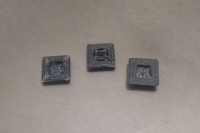In my post about Open Projects, I mentioned this project, and now I'm officially announcing it. This is a JavaScript based emulator of the 65C02 processor that runs in the browser. My plan is to write assembly and load the assembled binaries into the emulator where I can test them. Eventually, the page will be hosted on a public site where other people can try the software for the 6502 calculator I'm working on and report bugs.
Before I started on this project, I looked at a lot of other browser based emulators hoping I could use one of them. Some are unbelievably slow, working at way less than 1MHz and would not work well to test the calculator code that will eventually run at at least 10MHz. All of the emulators I looked at also lacked bank switching. The calculator will probably need several hundred kilobytes of memory which none of the emulators provide. The last reason is being able to map the peripherals into memory how I like and have them resemble the actual physical calculator I'll build when the software is finished.
The slower emulators I looked at do the emulation and interface in one thread as far as I can tell. Doing the emulation in a second thread with a Web Worker is a huge performance increase. In my emulator, the emulation thread performs a set number of instructions then checks in with the interface thread to get keyboard input and relay new screen contents. Setting the number of instructions to 1,000,000 yields around 70MHz performance, which is five times faster than the actual chip. It also makes typing a little unresponsive, so I set it to just 100,000 which is a good balance between responsiveness and performance of around 20MHz.
The emulation code ended up fairly compact. This is my first JavaScript project, and when I showed it to someone asking for advice, he said it looked like low-level C code. Each addressing mode has its own function and each operation (ADC, AND, ORA, etc) has its own function. The functions for the instructions themselves are very short since they are mostly combinations of those two types of functions. Rather than a switch statement, I use the op codes to index into an array of functions, which is probably a lot faster. This is how I would do it in C and it works in JavaScript, although the guy who was helping me pointed out that there are higher level structures in JavaScript that you could use instead. Banking works by splitting the first three 16k segments into banks (minus the first 200 bytes for zero page and the stack) and leaving the fourth segmented unbanked since it will always be EEPROM.
The first thing I tried when I got the emulator working was the test suite by Klaus Dormann. It passed after a few modifications, mostly to memory address wrapping. Then I mapped two banks of RAM to a simulated 256x128 video output where each pixel is represented by one byte. The final calculator might be black and white or have less color resolution, but I'll use this for now. I made a simple font which is copied to the display memory pixel by pixel. This didn't look especially impressive, so I found a much better looking one online to use instead. Next I added support for transparent backgrounds.
I got EhBASIC running after a couple days of fighting with it. The first command entered would work and the second would fail with "Syntax Error" depending on what the command was. I tried all kinds of things to find the problem, including stepping through the code to evaluate input, before I tracked it down to a location in zero page. It looked like one of the bytes there holding interrupt information was somehow corrupt since the error was thrown after it was evaluated. The source listed a handful of zero page bytes as free to use, so I put the pointer for updating the screen there. As it turns out, the byte is not actually free! Everything worked fine after I moved the pointer somewhere else.














